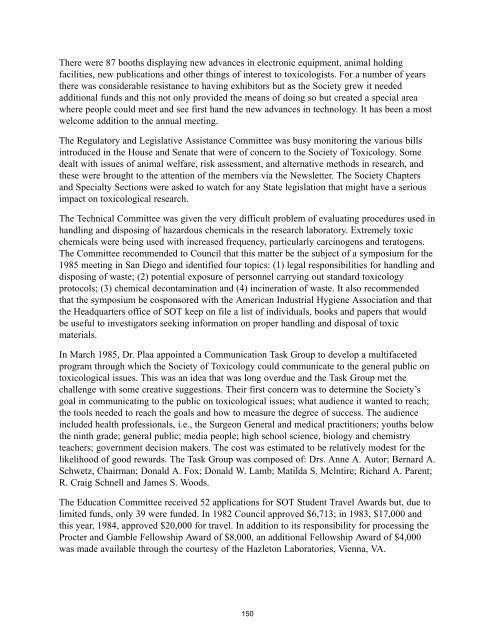SOCIETY O. TOXICOLOGY HISTORY - Society of Toxicology
SOCIETY O. TOXICOLOGY HISTORY - Society of Toxicology
SOCIETY O. TOXICOLOGY HISTORY - Society of Toxicology
Create successful ePaper yourself
Turn your PDF publications into a flip-book with our unique Google optimized e-Paper software.
There were 87 booths displaying new advances in electronic equipment, animal holding<br />
facilities, new publications and other things <strong>of</strong> interest to toxicologists. For a number <strong>of</strong> years<br />
there was considerable resistance to having exhibitors but as the <strong>Society</strong> grew it needed<br />
additional funds and this not only provided the means <strong>of</strong> doing so but created a special area<br />
where people could meet and see first hand the new advances in technology. It has been a most<br />
welcome addition to the annual meeting.<br />
The Regulatory and Legislative Assistance Committee was busy monitoring the various bills<br />
introduced in the House and Senate that were <strong>of</strong> concern to the <strong>Society</strong> <strong>of</strong> <strong>Toxicology</strong>. Some<br />
dealt with issues <strong>of</strong> animal welfare, risk assessment, and alternative methods in research, and<br />
these were brought to the attention <strong>of</strong> the members via the Newsletter. The <strong>Society</strong> Chapters<br />
and Specialty Sections were asked to watch for any State legislation that might have a serious<br />
impact on toxicological research.<br />
The Technical Committee was given the very difficult problem <strong>of</strong> evaluating procedures used in<br />
handling and disposing <strong>of</strong> hazardous chemicals in the research laboratory. Extremely toxic<br />
chemicals were being used with increased frequency, particularly carcinogens and teratogens.<br />
The Committee recommended to Council that this matter be the subject <strong>of</strong> a symposium for the<br />
1985 meeting in San Diego and identified four topics: (1) legal responsibilities for handling and<br />
disposing <strong>of</strong> waste; (2) potential exposure <strong>of</strong> personnel carrying out standard toxicology<br />
protocols; (3) chemical decontamination and (4) incineration <strong>of</strong> waste. It also recommended<br />
that the symposium be cosponsored with the American Industrial Hygiene Association and that<br />
the Headquarters <strong>of</strong>fice <strong>of</strong> SOT keep on file a list <strong>of</strong> individuals, books and papers that would<br />
be useful to investigators seeking information on proper handling and disposal <strong>of</strong> toxic<br />
materials.<br />
In March 1985, Dr. Plaa appointed a Communication Task Group to develop a multifaceted<br />
program through which the <strong>Society</strong> <strong>of</strong> <strong>Toxicology</strong> could communicate to the general public on<br />
toxicological issues. This was an idea that was long overdue and the Task Group met the<br />
challenge with some creative suggestions. Their first concern was to determine the <strong>Society</strong>’s<br />
goal in communicating to the public on toxicological issues; what audience it wanted to reach;<br />
the tools needed to reach the goals and how to measure the degree <strong>of</strong> success. The audience<br />
included health pr<strong>of</strong>essionals, i.e., the Surgeon General and medical practitioners; youths below<br />
the ninth grade; general public; media people; high school science, biology and chemistry<br />
teachers; government decision makers. The cost was estimated to be relatively modest for the<br />
likelihood <strong>of</strong> good rewards. The Task Group was composed <strong>of</strong>: Drs. Anne A. Autor; Bernard A.<br />
Schwetz, Chairman; Donald A. Fox; Donald W. Lamb; Matilda S. Mclntire; Richard A. Parent;<br />
R. Craig Schnell and James S. Woods.<br />
The Education Committee received 52 applications for SOT Student Travel Awards but, due to<br />
limited funds, only 39 were funded. In 1982 Council approved $6,713; in 1983, $17,000 and<br />
this year, 1984, approved $20,000 for travel. In addition to its responsibility for processing the<br />
Procter and Gamble Fellowship Award <strong>of</strong> $8,000, an additional Fellowship Award <strong>of</strong> $4,000<br />
was made available through the courtesy <strong>of</strong> the Hazleton Laboratories, Vienna, VA.<br />
150
















